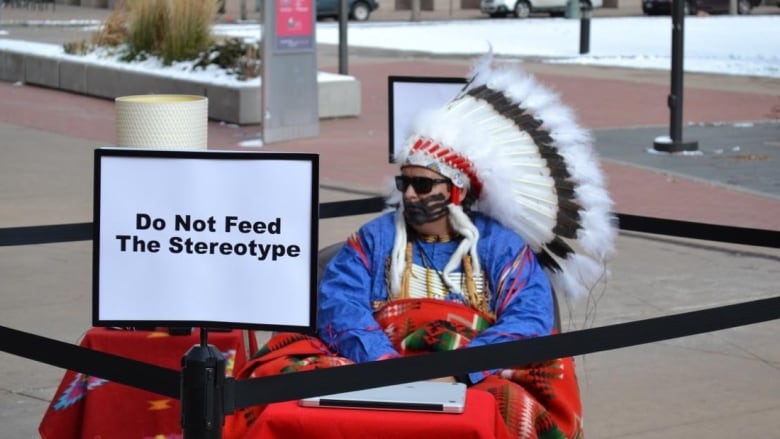Performance art challenges public's perception of indigenous stereotypes


It's a photo that was making the rounds on social media recently. The image is of a fully dressed Plains Indian — with headdress — sitting in a small roped off area on a busy sidewalk.
A sign outside the velvet rope reads, "Please do not feed the stereotype". The twist? Everything artist Gregg Deal is wearing in the piece was mass produced in China.
It represents "the inept understanding Americans have, or westerners have, to what indigeneity is and what it isn't," Deal said. "So in essence, I'm a stereotype personified."
Ethnographic Zoo is a performance piece created by Deal, the artist-in-residence at the Denver Art Museum. "The real ethnographic zoos that existed in museum in western culture, [were] basically taking brown people and putting them on display in western cities, gawking at, essentially, the 'other'," Deal said.
Reaction to this latest work, Deal said, was mixed. "Some people laughed, some people were annoyed, some people walked by," Deal said. "One woman, which I have on video, got behind me and was pulling on the feathers on the headpiece."
So much of my work is based on indigenous identity, particularly as it exists in popular culture.- Gregg Deal, artist
With fashion appropriated from indigenous cultures walking the runways and discussion of team mascots filling the airwaves, Deal said art has a unique ability to address the topic in a different way.
"Finding other places and other mediums with which to have these conversations, to have meaningful conversations, in a format and a way that people have open hearts and open minds is probably the biggest key," he said.
For Deal, taking his work to the street offers access to people he wouldn't otherwise interact with.
"Performance art is not confined to a gallery, it's often out in public," he said. "Which is sort of like doing it out in the wild west."

"To me, art is an expression of life. This is part of the indigenous experience, as a contemporary artist, you can see what I'm looking at and what I'm thinking about as a modern, native man."
Deal said stereotypes like the ones he's exploring in Ethnographic Zoo are problematic because they don't allow indigenous people to assert their own identity.
"This is my experience as an indigenous person and I don't think it's unique. But I will continue to share those things because it's part of my life's work."